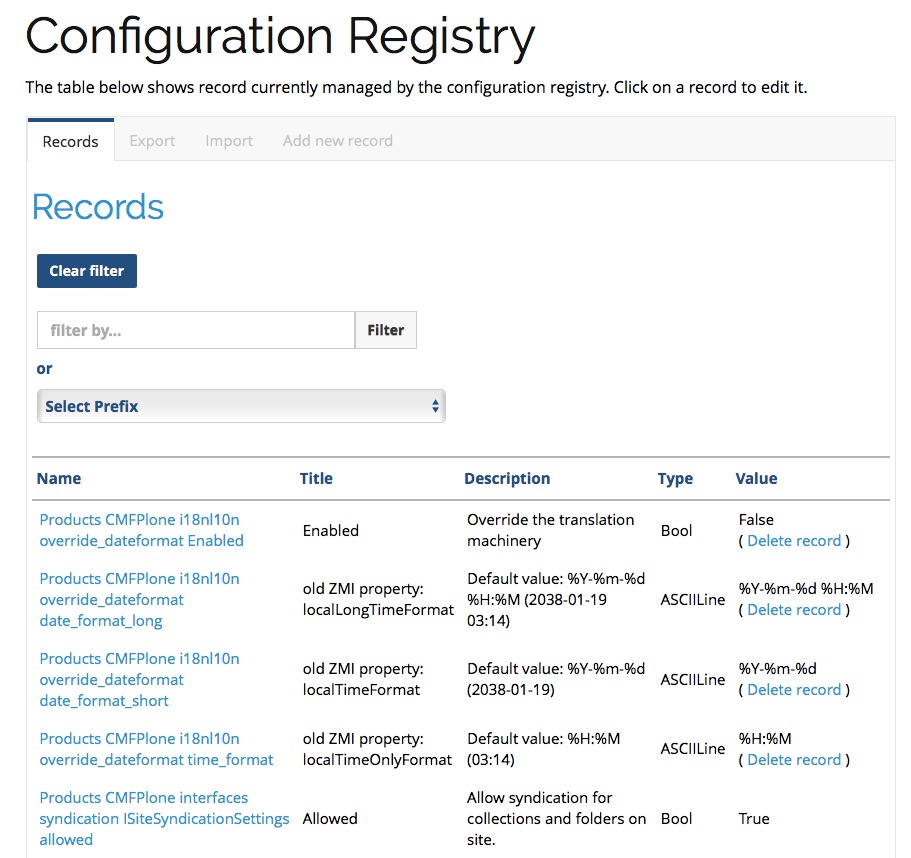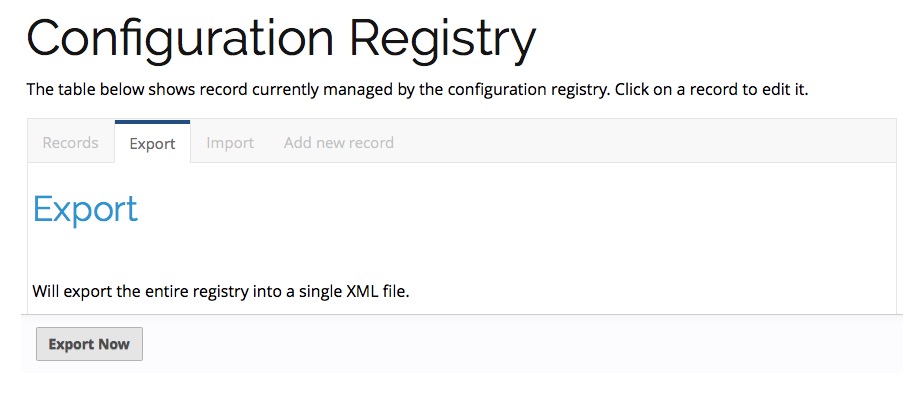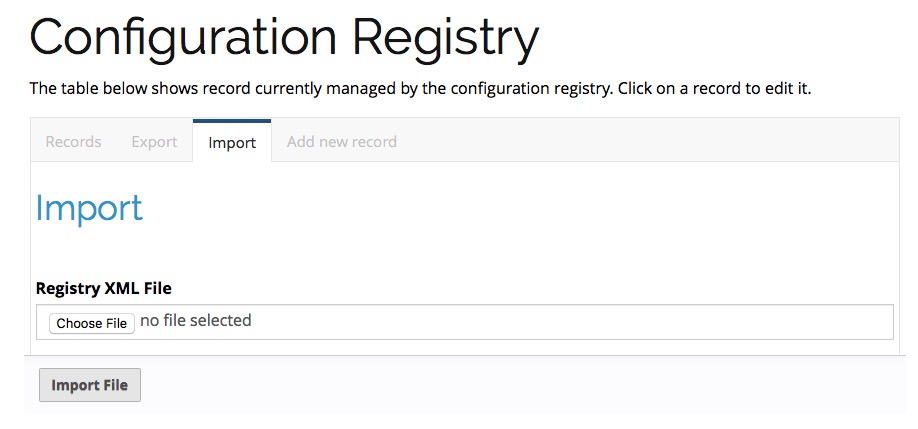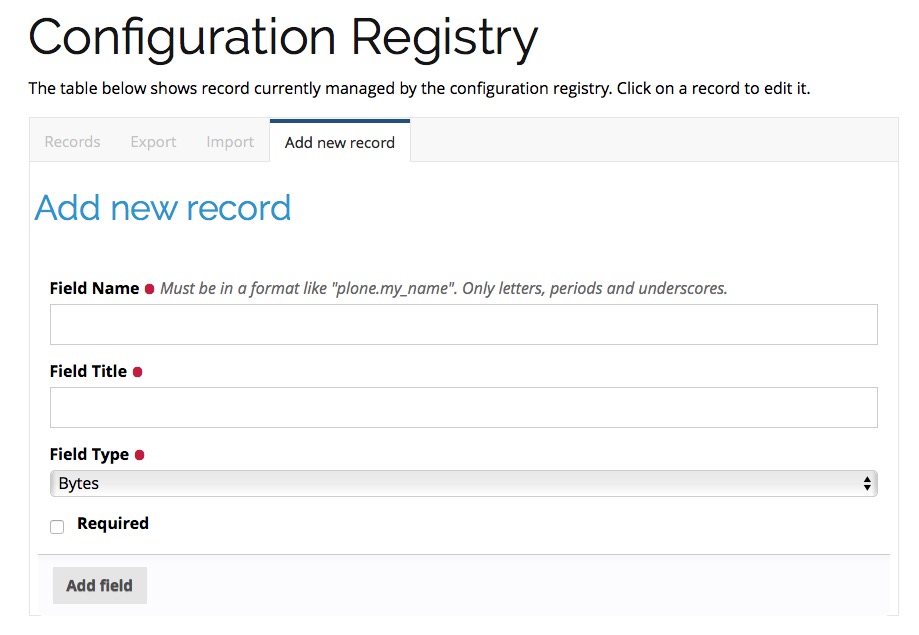plone.app.registry provides Plone UI and GenericSetup integration for
plone.registry, which in turn implements a configuration registry for
Zope applications. For details about how the registry works, please see the
plone.registry documentation. What follows is a brief overview of common
usage patterns in Plone.
Table of contents
The registry provided by plone.registry is intended to store settings in a safe, easily accessible manner. This makes it well-suited for applications and add-on products that need to manage some configurable, user-editable values. It is intended to replace the use of (less powerful and user friendly) Zope 2 property sheets, as well as (less safe and more difficult to access) persistent local utilities for managing such configuration.
The registry is not an arbitrary data store. For the most part, you can store any Python primitive there, but not more complex data structures or objects. This means that the registry cannot be broken by packages being uninstalled, and that it can provide a simple, generic user interface for editing values.
The registry is made up of records. A record consists of a field,
describing the record, and a value. Fields are based on the venerable
zope.schema, although the standard allowable field types are defined in
the module plone.registry.field. (This is partly because the field
definitions are actually persisted with the record, and partly because
plone.registry performs some additional validation to ensure the integrity
of the registry).
A record can be created programmatically, though in a Plone context it is more
common to install records using the records.xml GenericSetup syntax. Once
the record has been created, its value can be read and set using standard
Python dictionary syntax. Accessing the record and field is just as easy.
Each record has a unique name, which must be a dotted name prefixed by the
package owning the record. For example, a record owned by the package
my.package could have a name like my.package.myrecord.
As of version 1.6, it is possible to split registry.xml into
multiple files; to import and export registry entries via the control
panel; and to add and delete records via the control panel.
- versions 1.3 and later are for Plone 5.
- versions 1.2.x are for Plone 4.
This section describes how the registry is most commonly used in a Plone context. For more details, please see the plone.registry documentation.
The best way to create, modify and delete registry records when writing Plone add-on products is normally to use GenericSetup.
Once you have decided that you need a particular record, you need to answer two questions:
- What should the record be called?
- What type of data should it hold?
Let's say you wanted to create a record call my.package.timeout, holding
an integer. Integers are described by the field type
plone.registry.field.Int. Almost all the standard fields you would find
in zope.schema have an equivalent field in plone.registry.field. The
main exception is Object, which is unsupported. Also, Choice fields
only support vocabularies given by string name, or as a list of string values.
Finally, you cannot use the constraint property to set a validator
function, although other validation (such as min/max values) will work.
To install such a record, you could add a registry.xml step to the
GenericSetup profile of your product like this:
<registry>
<record name="my.package.timeout">
<field type="plone.registry.field.Int">
<title>Timeout</title>
<min>0</min>
</field>
<value>100</value>
</record>
</registry>
Let's look at this in more detail:
- There is one record declared. The name is given in the
nameattribute. - In the record, we first define the field type, by giving the full dotted
name to the field class. Unless you have installed a third party package
providing additional persistent fields, this will be a class in
plone.registry.fieldmirroring a corresponding class inzope.schema. - Inside the
<field />element, we list any required or optional attributes of the field. This uses plone.supermodel syntax. In essence, each allowed field attribute is represented by a tag (so thetitleattribute can be set with the<title />tag), with the attribute value given as the tag body. If an attribute is required for a field, the corresponding tag is required here. - We then set the value. This must obviously be a valid value for the field type.
Note that the <value /> is optional. If not given, the field will default
to its missing_value until it is set. The <field /> is optional if
the record has already been initialised elsewhere.
Most field attributes are simple tags like the ones shown above, with the
field name used as the tag name, and a string representation of the value
used as the contents of the tag. Collection fields are a little more involved,
however. A collection field (like a List or Tuple) has a
value_type property containing another field. Also, their values and
defaults are sequences. Let's look at an example:
<record name="my.package.animals">
<field type="plone.registry.field.Tuple">
<title>Animals</title>
<description>A list of cool animals</description>
<value_type type="plone.registry.field.TextLine" />
</field>
<value>
<element>Dog</element>
<element>Cat</element>
<element>Elephant</element>
</value>
</record>
Notice how the <value_type /> tag takes a type attribute just like
the outer <field /> tag. Here we have shown a value type with no options,
but if you need, you can put tags for additional field attributes inside the
<value_type /> tag.
Also notice how the value is represented. Each element in the sequence (a
tuple in this case) is given by an <element /> tag, with the element
value given as the body of that tag.
Dict fields also have a <key_type /> and elements that are key/value
pairs. They can be configured like so:
<record name="my.package.animalFood">
<field type="plone.registry.field.Dict">
<title>Food eaten by animals</title>
<key_type type="plone.registry.field.TextLine" />
<value_type type="plone.registry.field.TextLine" />
</field>
<value>
<element key="Dog">Dog food</element>
<element key="Cat">Cat food</element>
<element key="Elephant">Squirrels</element>
</value>
</record>
Instead of storing registry entries in a single, large
registry.xml file, you can have Generic Setup load and process
registry entries from multiple files. This makes it easier to manage
and organize the registry entries provided by your applications and
add-ons.
Your add-on should include a folder named registry in its
profile(s) folders, e.g. profiles/default/registry. Any XML files
in that folder will be read and processed by the registry the same way
it would have read and processed a single registry.xml file in
the profiles/default folder.
As an example, see how Castle CMS uses multiple XML files in its profiles/default/registry folder.
The registry will process both the registry.xml file and the
contents of a registry folder, if both exist.
Importable records in registry.xml can be marked conditional with
condition attribute, which supports the following condition values:
installed my.package, which causes record to be imported only when python modulemy.packageis available to be imported.not-installed my.package, which causes record to be imported only when python modulemy.packageis not available to be imported:have my-feature, which causes record to be imported only when ZCML feature flagmy-featurehas been registered (Zope2 only)not-have my-feature, which causes record to be imported only when ZCML feature flagmy-featurehas not been registered (Zope2 only)
For example, the following registry.xml step at the GenericSetup profile of
your policy product, would only import records when module my.package is
available:
<registry>
<records interface="my.package.interfaces.IZooSettings"
condition="installed my.package">
<value key="entryPrice">40</value>
<value key="messageOfTheDay">We've got lions and tigers!</value>
</records>
</registry>
It is possible to define record to use another record's field. This is often useful if you want one record to act as an optional override for another. For example:
<registry>
<record name="my.package.timeout">
<field type="plone.registry.field.Int">
<title>Timeout</title>
<min>0</min>
</field>
<value>100</value>
</record>
<record name="my.package.timeout.slowconnection">
<field ref="my.package.timeout" />
<value>300</value>
</record>
</registry>
In this example, we have defined the my.package.timeout record with an
integer field. We then have a separate record, with a separate value,
called my.package.timeout.slowconnection, which uses the same field
(with the same type, validation, title, description, etc). This avoids having
to explicitly re-define a complete field.
Note: The field in this case is actually a FieldRef object. See the
plone.registry documentation for details.
Once a record has been defined, its value can be set or updated using GenericSetup like so:
<record name="my.package.animalFood">
<value purge="false">
<element key="Squirrel">Nuts</element>
<element key="Piranha">Other piranha</element>
</value>
</record>
This is often useful if you have a record defined in one package that is appended to or customised in another package.
In the example above, we used the purge attribute. When setting the value
of a multi-valued field such as a tuple, list, set or dictionary, setting this
attribute to false will cause the values listed to be added to the
existing collection, rather than overriding the collection entirely, as would
happen if the purge attribute was set to true or omitted.
To delete a record, use the remove attribute:
<record name="my.package.animalFood" remove="true" />
If the record does not exist, a warning will be logged, but processing will continue.
In the examples above, we created individual records directly in the registry.
Sometimes, however, it is easier to work with traditional schema interfaces
that group together several related fields. As we will see below,
plone.registry and plone.app.registry provide certain additional
functionality for groups of records created from an interface.
For example, we could have an interface like this:
from zope.interface import Interface
from zope import schema
class IZooSettings(Interface):
entryPrice = schema.Decimal(title=u"Admission charge")
messageOfTheDay = schema.TextLine(title=u"A banner message", default=u"Welcome!")
Notice how we are using standard zope.schema fields. These will be
converted to persistent fields (by adapting them to IPersistentField from
plone.registry) when the registry is populated. If that is not possible,
an error will occur on import.
To register these records, we simply add the following to registry.xml:
<records interface="my.package.interfaces.IZooSettings" />
This will create one record for each field. The record names are the full
dotted names to the fields, so in this case they would be
my.package.interfaces.IZooSettings.entryPrice and
my.package.interfaces.IZooSettings.messageOfTheDay.
If you just want to use the interface as a template you can supply a
prefix attribute:
<records interface="my.package.interfaces.IZooSettings" prefix="my.zoo" />
which will generate fields named my.zoo.entryPrice and
my.zoo.messageOfTheDay.
In order to set the values of the fields created by a <records /> directive
you must provide value entries with keys corresponding to the fields on
the interface, as follows:
<records interface="my.package.interfaces.IZooSettings" prefix="my.zoo">
<value key="entryPrice">40</value>
<value key="messageOfTheDay">We've got lions and tigers!</value>
</records>
Values can be set as above using the full record name. However, we can also explicitly state that we are setting a record bound to an interface, like so:
<record interface="my.package.interfaces.IZooSettings" field="entryPrice">
<value>10.0</value>
</record>
This is equivalent to:
<record name="my.package.interfaces.IZooSettings.entryPrice">
<value>10.0</value>
</record>
You can also use the interface/field syntax to register a new record
from an individual field.
Finally, if the interface contains fields that cannot or should be set, they may be omitted:
<records interface="my.package.interfaces.IZooSettings">
<omit>someField</omit>
</records>
The <omit /> tag can be repeated to exclude multiple fields.
To delete a set of records, based on an interface use the remove
attribute:
<records interface="my.package.interfaces.IZooSettings" remove="true" />
If the record does not exist for any of the interface fields, a warning will be logged, but processing will continue.
If you do not wish to delete, or wish to exclude certain fields, they may be omitted:
<records interface="my.package.interfaces.IZooSettings" remove="true">
<omit>someField</omit>
</records>
The <omit /> tag can be repeated to exclude multiple fields.
Now that we have seen how to manage records through GenericSetup, we can start using values from the registry in our code.
To get or set the value of a record, we must first look up the registry itself. The registry is registered as a local utility, so we can look it up with:
from zope.component import getUtility from plone.registry.interfaces import IRegistry registry = getUtility(IRegistry)
Values can now get read or set using simple dictionary syntax:
timeout = registry['my.package.timeout']
We can also use get() to get the value conditionally, and an in check
to test whether the registry contains a particular record.
The returned value will by of a type consistent with the field for the record with the given name. It can be set in the same manner:
registry['my.package.timeout'] = 120
If you need to access the underlying record, use the records attribute:
timeoutRecord = registry.records['my.package.timeout']
The record returned conforms to plone.registry.interfaces.IRecord and has
two main attributes: value is the current record value, and field is
the persistent field instance. If the record was created from an interface,
it will also provide IInterfaceAwareRecord and have three additional
attributes: interfaceName, the string name of the interface;
interface, the interface instance itself, and fieldName, the name of
the field in the interface from which this record was created.
You can delete the whole record programmatically with the Python del
statement:
del registry.records['my.package.timeout']
In unit tests, it may be useful to create a new record programmatically. You can do that like so:
from plone.registry.record import Record from plone.registry import field registry.records['my.record'] = Record(field.TextLine(title=u"A record"), u"Test")
The constructor takes a persistent field and the initial value as parameters.
To register records for an interface programmatically, we can do:
registry.registerInterface(IZooSettings)
You can omit fields by passing an omit parameter giving a sequence of
omitted field names.
See plone.registry for more details about how to introspect and manipulate
the registry records programmatically.
You can also access the registry from page templates. Example TALES expression:
python:context.portal_registry['plone.app.theming.interfaces.IThemeSettings.enabled']
Above, we used dictionary syntax to access individual records and values. This
will always work, but for so-called interface-aware records - those which were
created from an interface e.g. using the <records /> syntax - we have
another option: the records proxy. This allows us to look up all the records
that belong to a particular interface at the same time, returning an object
that provides the given interface and can be manipulated like an object, that
is still connected to the underlying registry.
To look up a records proxy for our IZooSettings interface, we can do:
zooSettings = registry.forInterface(IZooSettings)
The zooSettings object now provides IZooSettings. Values may be
read and set using attribute notation:
zooSettings.messageOfTheDay = u"New message" currentEntryPrice = zooSettings.entryPrice
When setting a value, it is immediately validated and written to the registry. A validation error exception may be raised if the value is not permitted by the field for the corresponding record.
When fetching the records proxy, plone.registry will by default verify
that records exists for each field in the interface, and will raise an error
if this is not the case. To disable this check, you can do:
zooSettings = registry.forInterface(IZooSettings, check=False)
This is sometimes useful in cases where it is not certain that the registry
has been initialised. You can also omit checking for individual fields, by
passing an omit parameter giving a tuple of field names.
To delete a record is as simple as:
del registry.records['plone.app.theming.interfaces.IThemeSettings.enabled']
The registry emits events when it is modified:
plone.registry.interfaces.IRecordAddedEventis fired when a record has been added to the registry.plone.registry.interfaces.IRecordRemovedEventis fired when a record has been removed from the registry.plone.registry.interfaces.IRecordModifiedEventis fired when a record's value is modified.
You can register subscribers for these to catch any changes to the registry. In addition, you can register an event handler that only listens to changes pertaining to records associated with specific interfaces. For example:
from zope.component import adapter
from plone.registry.interfaces import IRecordModifiedEvent
from logging import getLogger
log = getLogger('my.package')
@adapter(IZooSettings, IRecordModifiedEvent)
def detectPriceChange(settings, event):
if record.fieldName == 'entryPrice':
log.warning("Someone change the price from %d to %d" % (event.oldValue, event.newValue,))
See plone.registry for details about these event types.
The generic control panel is useful as a system administrator's tool for low- level configuration. If you are writing a package aimed more at system integrators and content managers, you may want to provide a more user-friendly control panel to manage settings.
If you register your records from an interface as shown above, this package provides a convenience framework based on plone.autoform and z3c.form that makes it easy to create your own control panel.
To use it, create a module like this:
from plone.app.registry.browser.controlpanel import RegistryEditForm
from plone.app.registry.browser.controlpanel import ControlPanelFormWrapper
from my.package.interfaces import IZooSettings
from plone.z3cform import layout
from z3c.form import form
class ZooControlPanelForm(RegistryEditForm):
form.extends(RegistryEditForm)
schema = IZooSettings
ZooControlPanelView = layout.wrap_form(ZooControlPanelForm, ControlPanelFormWrapper)
ZooControlPanelView.label = u"Zoo settings"
Register the ZooControlPanelView as a view:
<browser:page
name="zoo-controlpanel"
for="Products.CMFPlone.interfaces.IPloneSiteRoot"
permission="cmf.ManagePortal"
class=".controlpanel.ZooControlPanelView"
/>
Then install this in the Plone control panel using the controlpanel.xml
import step in your GenericSetup profile:
<?xml version="1.0"?>
<object
name="portal_controlpanel"
xmlns:i18n="http://xml.zope.org/namespaces/i18n"
i18n:domain="my.package">
<configlet
title="Zoo settings"
action_id="my.package.zoosettings"
appId="my.package"
category="Products"
condition_expr=""
url_expr="string:${portal_url}/@@zoo-controlpanel"
icon_expr="string:${portal_url}/++resource++my.package/icon.png"
visible="True"
i18n:attributes="title">
<permission>Manage portal</permission>
</configlet>
</object>
The icon_expr attribute should give a URL for the icon. Here, we have
assumed that a resource directory called my.package is registered and
contains the file icon.png. You may omit the icon as well.
This package provides the "Configuration Registry" control panel in Plone's Site Setup. Here, you can view all registry records, you can search for records using a case sensitive filter field, and you can select sets of records according to their prefix (e.g. "IDiscussionSettings", "plone.app.caching").
Registry records' names, titles, descriptions, data types and current values are displayed.
If you click on a record, an edit form appears that allows you to change its value.
You can use the Configuration Registry control panel's Export tab to
export the entire registry into a single XML file. When you click the
Export Now button, a file named registry.xml will be downloaded to
your computer.
To import registry entries, use the Configuration Registry control panel's Import tab, use the Choose File button to select an XML file from your computer containing the registry entries, then press the Import File button.
You can add individual registry records using the Configuration Registry control panel's "Add new record" tab.
Enter the registry record's name, (human readable) title, select a data type, and optionally check the Required box if the record must have a value. Then press the "Add field" button.
plone.app.registry provides RegistryEditForm class which is a subclass of
z3c.form.form.Form.
RegistryEditForm has two methods to override which and how widgets are going
to be used in the control panel form.
updateFields()may set widget factories i.e. widget type to be usedupdateWidgets()may play with widget properties and widget value shown to the user
Example (collective.gtags project controlpanel.py):
class TagSettingsEditForm(controlpanel.RegistryEditForm):
schema = ITagSettings
label = _(u"Tagging settings")
description = _(u"Please enter details of available tags")
def updateFields(self):
super(TagSettingsEditForm, self).updateFields()
self.fields['tags'].widgetFactory = TextLinesFieldWidget
self.fields['unique_categories'].widgetFactory = TextLinesFieldWidget
self.fields['required_categories'].widgetFactory = TextLinesFieldWidget
def updateWidgets(self):
super(TagSettingsEditForm, self).updateWidgets()
self.widgets['tags'].rows = 8
self.widgets['tags'].style = u'width: 30%;'
The following sections describe some commonly encountered problems, with suggestions for how to resolve them.
Both plone.app.z3cform (Plone z3c.form support) and plone.app.registry
(Configuration registry) add-ons must be installed at Plone site before you
can use any control panel configlets using plone.app.registry framework.
Example traceback:
Module plone.app.registry.browser.controlpanel, line 44, in getContent Module plone.registry.registry, line 56, in forInterface KeyError: 'Interface `mfabrik.plonezohointegration.interfaces.ISettings` defines a field `username`, for which there is no record.'
This means that
Your registry.xml does not define default values for your configuration keys
You have changed your configuration schema, but haven't rerun add-on installer to initialize default values
You might need to use the same prefix as you use for the interface name in your settings:
<records prefix="mfabrik.plonezohointegration.interfaces.ISettings" interface="mfabrik.plonezohointegration.interfaces.ISettings">




